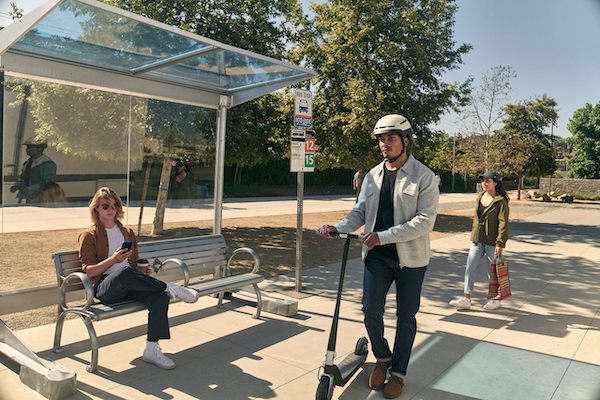This article is sponsored byAmazon.
Uber, the largest mobility platform in the world, has committed to being a fully electric, zero-emission platform by 2030 in the U.S., Canada and Europe and 2040 globally, with 100 percent of rides taking place in zero-emission vehicles, on public transit, or with micromobility (such as e-scooters and bikes).
Sally Fouts, Amazon’s global leader of The Climate Pledge, sat down with Thibaud Simphal, Uber’s new global head of sustainability, to learn about the company’s aggressive climate goals, plans for helping drivers make the switch to electric vehicles, expansion of micromobility, and his advice for other transportation and mobility companies interested in prioritizing climate solutions.
Sally Fouts:You’re already transitioning thousands of drivers to electric vehicles (EVs) through your Green Future program. Tell us about that.

Thibaud Simphal, Global Head of Sustainability at Uber. Image courtesy of Uber.
Thibaud Simphal:Helping drivers transition equitably to EVs is a big part of building the future of sustainable mobility. Research shows that when rideshare drivers switch to EVs, they can deliver three to four times the emissions savings compared to the average car owner.
Our Green Future program provides access to resources valued at $800 million to help hundreds of thousands of drivers transition to battery electric vehicles (BEVs) by 2025. These resources include new earnings opportunities for drivers with greener and electric vehicles, such as Uber Green (a low-emission ride option) and incentives to encourage them to go fully electric such as negotiated discounts and savings on EVs and EV charging.
For example, we’ve teamed up with Hertz to make up to 50,000 fully electric Tesla rentals available to drivers in the U.S. by 2023, and partnered with Wallbox and Greenlots (soon to become Shell Recharge Solutions) to offer drivers using Uber in the San Francisco Bay Area and Vancouver, British Columbia, access to affordable home charging solutions.
Fouts:Uber plans to operate as a zero-emission mobility platform in the U.S., Canada and Europe by 2030. That’s huge. How will you get there?
Simphal:Uber is leading the industry to zero emissions by focusing on three key actions:
- Helping drivers go electric as fast as possible,
- Empowering consumers to choose green and car-free products, and;
- Being transparent about our climate impact each year so we’re accountable for improvement.
EV use on Uber more than doubled in the year after we made our zero-emissions commitment, and we’re already seeing significant progress in cities like London, where more than 1 in 10 miles on our app are now fully electric. London is a great example of how quickly electrification can scale when you have strong partnership with both private and public leaders.
Fouts: How do you message the importance of zero emissions vehicles and a net-zero carbon future to drivers and riders?
Simphal:Education is a crucial part of our efforts. When we speak with EV drivers, what we hear is that they’re overwhelmingly satisfied they’ve made the switch to driving an EV on the Uber platform. But there’s still a lot of education to do for both drivers and riders. In Europe, we’ve introduced an EV ambassador program, as well as webinars and events. We’ve also worked with third parties to offer drivers a Total Cost of Ownership calculator, customizable down to the city level, so a driver can see what EV incentives are available to them. It even helps drivers do a side-by-side operation cost comparison between their current vehicle and an EV.
Additionally, we’ve given riders across the world access to sustainable mobility products. Seeing is believing, and one of the best ways for people to learn about EVs is by riding in one. As the number of Uber EV drivers increases, the more riders get first-hand experience with them. Uber Green is now available in more than 100 major urban markets across multiple continents and over a dozen countries making it the most widely available on-demand mobility solution in the world for no- or low-emission rides.

Affordable, easy to use, and good for the planet, Lime electric scooters are available through the Uber app. Image courtesy of Uber.
Fouts: And what about your micromobility options?
Simphal:We’re currently providing riders in 170 global metropolitan markets access to in-app car-free options including electric mopeds, bikes and scooters. We also offer public transportation products in more than 40 major markets, including public transit journey planning (the time and cost comparison between options when selecting your route in-app) and first and last-mile solutions for transit agencies.
We need to continue building products that make it simple for people to maintain a car-free or car-light lifestyle. Being able to take an electric bike or scooter at the tap of a button changes how people move around cities. They also extend access to other ways of going green, such as making a bus or train stop that was too far away on foot suddenly a whole lot closer.
By offering a variety of ways to get from A to B, we can make it easier to enable healthy urban living and decrease the dependency on car ownership.
Fouts: How about at the office? Beyond electrifying your full transportation fleet, what are Uber’s key sustainability goals for company operations and corporate headquarters?
Simphal:We’ve committed to net-zero emissions from all corporate operations by 2030, and net-zero total climate emissions across scopes 1, 2 and 3 by 2040.
We currently factor in environmental considerations into site selection of workplaces, data center strategy and planning, and when choosing which suppliers we work with.
In the U.S., we’ve committed to powering our offices with 100 percent renewable energy by 2025 and we’re making great progress. In our Phoenix center, 100 percent of electricity is matched with renewable energy, and in Texas we’ve recently signed a purchase agreement with Enel Green Power’s Azure Sky wind farm. Having sustainable offices and operations is not only good for our planet, it’s good for our people.

Drivers are eager to make the transition to electric vehicles, and Uber is committed to supporting them. Image courtesy of Uber.
Fouts:Anything else you want to share with us?
Simphal:We deeply appreciate the incredible work done by Climate Pledge companies and policy leaders around the world. Climate action is a team sport and it will take public and private sectors working together to achieve change at the speed and scale we need. As the largest mobility platform in the world, Uber will keep driving hard to do our part to meet our ambitious climate goals. We look forward to partnering with companies and governments to achieve wider change.
Fouts:What’s your advice for other transportation and mobility companies interested in aggressively prioritizing climate solutions?
Simphal:There’s no time to waste. Bring in the experts, set aggressive goals, build your plan and hold yourself accountable by publishing your carbon impact each year. We can make so much progress so much faster if the industry collectively takes action.




